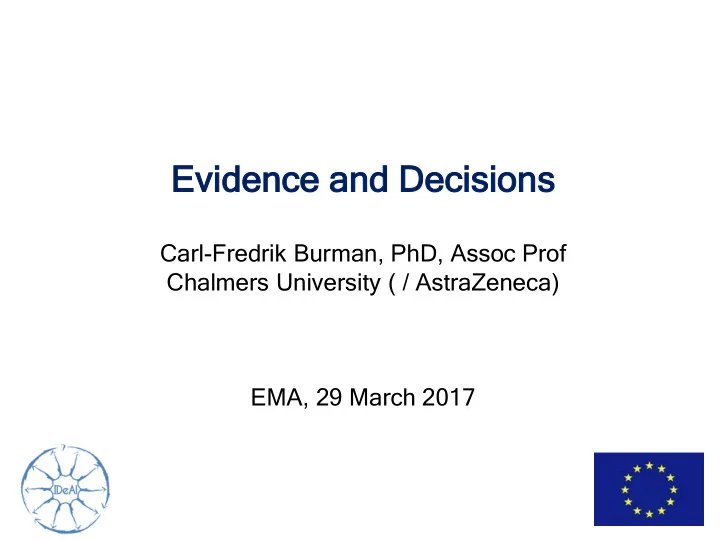

Evidenc dence and D d Decisions ons Carl-Fredrik Burman, PhD, Assoc Prof Chalmers University ( / AstraZeneca) EMA, 29 March 2017
This project has received funding from the European Union’s 7th Framework Programme for research, technological development and demonstration under the IDEAL Grant Agreement no 602552. The views expressed are the author’s own and may not necessarily express those of IDEAL, AZ or Chalmers Univ.
p < α EMA 1: Does trt work?
p < α EMA 1: Does trt work? B > k ⋅ R EMA 2: Benefit / risk
p < α EMA 1: Does trt work? B > k ⋅ R EMA 2: Benefit / risk (B-k´ ⋅ R)/C Payer: Cost-effective
p < α EMA 1: Does trt work? B > k ⋅ R EMA 2: Benefit / risk (B-k´ ⋅ R)/C Payer: Cost-effective B i > k i ⋅ R i Patient: Good for me?
p < α EMA 1: Does trt work? B > k ⋅ R EMA 2: Benefit / risk (B-k´ ⋅ R)/C Payer: Cost-effective B i > k i ⋅ R i Patient: Good for me? Return on Investment (ROI)
p < α EMA 1: Does trt work? B > k ⋅ R EMA 2: Benefit / risk (B-k´ ⋅ R)/C Payer: Cost-effective Mechanism design B i > k i ⋅ R i Patient: Good for me? Return on Investment (ROI)
What’s important? “Salus aegroti” (The well-being of the patient)
Not all rare diseases are equal Rare disease ≠ neglected disease
p < α EMA 1: Does trt work? B > k ⋅ R EMA 2: Benefit / risk (B-k´ ⋅ R)/C Payer: Cost-effective Mechanism design B i > k i ⋅ R i Patient: Good for me? Return on Investment (ROI)
“Level of evidence”, α, should depend on disease population size etc. Stallard et al. (2017) Miller & Burman (2017, submitted)
Efficiency - bias tradeoff • Pooling data over time points • Dichotomous -> continuous endpoints • Highly informative endpoints • Borrowing data (historic, other populations) • Cross-over • Optimal sample size Burman (2015)
p < α EMA 1: Does trt work? B > k ⋅ R EMA 2: Benefit / risk (B-k´ ⋅ R)/C Payer: Cost-effective Mechanism design B i > k i ⋅ R i Patient: Good for me? Return on Investment (ROI)
In-transparency in • Benefit/risk assessment (k, k´) and/or • Willingness to pay lead to fewer drugs being developed and less value to patients Jobjörnsson, Forster, Pertile, Burman (2016) Jobjörnsson (2016; Section 3.3)
Lack of regulator-payer alignment lead to fewer drugs being developed and less value to patients
p < α EMA 1: Does trt work? B > k ⋅ R EMA 2: Benefit / risk (B-k´ ⋅ R)/C Payer: Cost-effective Mechanism design B i > k i ⋅ R i Patient: Good for me? Return on Investment (ROI)
Individualised • Benefit • Risk • Preferences
Biomarker-defined subpopulations • Level of evidence in BM negatives • Should we test a null hypothesis we know is wrong? Ondra, Jobjörnsson, Beckman, Burman, König, Stallard, Posch (2016)
p < α EMA 1: Does trt work? B > k ⋅ R EMA 2: Benefit / risk (B-k´ ⋅ R)/C Payer: Cost-effective Mechanism design B i > k i ⋅ R i Patient: Good for me? Return on Investment (ROI)
Incentivising mechanisms: • Level of evidence needed to depend on context • Progressive pay
p < α EMA 1: Does trt work? B > k ⋅ R EMA 2: Benefit / risk (B-k´ ⋅ R)/C Payer: Cost-effective Mechanism design B i > k i ⋅ R i Patient: Good for me? Return on Investment (ROI)
Recommend
More recommend